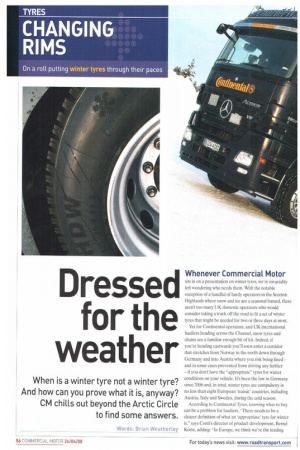ressed for the weather
Page 56

Page 57

If you've noticed an error in this article please click here to report it so we can fix it.
When is a winter tyre not a winter tyre? And how can you prove what it is, anyway? CM chills out beyond the Arctic Circle to find some answers.
Words: Brian Weathertey
Whenever Commercial Motor
sits in on a presentation on winter tyres, we're invariably left wondering who needs them. With the notable exception of a handful of hardy operators in the Scottish Highlands where snow and ice are a seasonal hazard, there aren't too many UK domestic operators who would consider taking a truck off the road to fit a set of winter tyres that might be needed for two or three days at most.
Yet for Continental operators, and UK international hauliers heading across the Channel, snow tyres and chains are a familiar enough hit of kit. Indeed, if you're heading eastwards you'll soon enter a corridor that stretches from Norway in the north down through Germany and into Austria where you risk being fined and in some cases prevented from driving any further if you don't have the "appropriate" tyres for winter conditions on your vehicle. It's been the law in Germany since 2006 and, in total, winter tyres are compulsory in no less than eight European 'transit' countries, including Austria, Italy and Sweden, during the cold season.
According to Continental Tyres, knowing what to buy can be a problem for hauliers. "There needs to be a clearer definition of what an 'appropriate' tyre for winter is," says Conti's director of product development, Bernd Korte, adding: "In Europe, we think we're the leading winter tyre firm — we've been supplying them since 1937."
The majority of Continen tal's winter tyre sales are to international hauliers and, particularly, coach operators.
"Two years ago, we didn't think it was a major-volume business," says Korte. "We sold to operators in Scandinavia and the Alps."
However, the business has grown and Conti now offers M+S (Mud and Snow) tyres for drive-axle, steer and trailer applications —as well as low-aspect versions. To keep any zealous policemen happy and help operators avoid a €40 (i32) fine, Conti now puts a large snowflake symbol on the sidewall of its winter tyres to prove the point. Moreover, along with other European tyre makers it has been pushing for the EU to set a minimum performance standard for winter tyres (see panel).
How do you test them?
But how do you prove the performance of a winter tyre? CM recently witnessed Conti's winter truck tyre testing on a specially prepared test track above the Arctic Circle in Arvidsjaur in Sweden.
Forget about simply driving a truck on a snow-covered road — it's much more scientific than that. Using two kilometre-long parallel straights of uniformly compacted snow and ice that are constantly tended to keep them in a consistent condition as the temperature fluctuates. Continental conducts a number of specific performance exercises to assess traction, braking and stability. Tests involve rigids, drawbars, artics and coaches.
During our time at the track, we had the opportunity to experience for ourselves the difference in traction between a 40-tonne Mercedes Actros artic fitted with winter rubber and one fitted with normal 'regional' distribution tyres. The procedure was relatively simple: you pull away from a standing start using full throttle and with the ASR operating. Then, using GPS satellite technology to identify the exact point at which the truck starts moving, a computer accurately calculates the difference in time and distance taken to reach 40km1h.
It was certainly strange to floor the accelerator pedal on either artic when common sense strongly suggests you start off more smoothly on snow and ice. But it's a necessary element of winter testing and, after a couple of practice runs, we had fallen into the groove of simply pushing the right pedal down to its maximum travel in one go, while letting the Actros's automatic transmission take care of the gearchanges.
Overall, we were typically four seconds quicker reaching 40knifh in the artic equipped with winter tyres than the one with the ordinary regional tyres, proving the former's superior traction. The difference may not sound much but, from the cab, it was obvious that the ASR had to do much less when pulling away on the specialist rubber. And, as many drivers have learned to their cost, when you're on an icy road, sometimes getting started with a fully laden truck can be the biggest problem. II












































































































































































